1,214-Foot Killer Asteroid Headed Towards Us This Friday: Will It Hit Earth?

NASA is currently tracking a massive potentially hazardous asteroid (PHA) that’s headed for Earth. According to the agency’s Center for Near Earth Object Studies (CNEOS), the approaching asteroid is almost as big as the Empire State Building.
CNEOS has identified the incoming asteroid as 2019 GT3. Based on the agency’s database, 2019 GT3 is one of the biggest asteroids that will approach Earth this month.
According to CNEOS, the asteroid is currently traveling at a speed of 30,500 miles per hour. It is estimated to have a diameter of 1,214 feet, making it significantly taller than the Eiffel Tower in Paris.
Given the asteroid’s massive size, it’s capable of creating a crater that’s about 3 miles wide if it collides with Earth. This means the asteroid is powerful enough to destroy an entire city during an impact event. Fortunately, it will not be coming too close to Earth.
CNEOS predicted that 2019 GT3 will fly past Earth on Sept. 6 at 12:21 am EDT. During its approach, the massive asteroid will be about 0.04996 astronomical units or around 4.6 million miles from the planet’s center.
2019 GT3 was first observed on April 3. Based on CNEOS’ database, the asteroid is also known to approach Mars and Jupiter. The asteroid’s next near-Earth approach will happen on June 20, 2030. During this time, the asteroid will zip past the planet from a distance of 0.09599 astronomical units or roughly 8.9 million miles away.
The agency categorized 2019 GT3 as an Apollo asteroid. Like other asteroids that belong to this family, 2019 GT3 has a very wide orbit around the Earth and the Sun. As it travels across space, the asteroid regularly crosses Earth’s path as it orbits the giant star.
Due to 2019 GT3’s close-intersections with Earth’s orbit, it has been classified by CNEOS as a potentially hazardous asteroid.
“Potentially hazardous asteroids are currently defined based on parameters that measure the asteroid’s potential to make threatening close approaches to the Earth,” CNEOS said in a statement. “Specifically, all asteroids with a minimum orbit intersection distance of 0.5 [astronomical units] or less and an absolute magnitude of 22.0 or less are considered PHAs.”
© Copyright IBTimes 2024. All rights reserved.





















